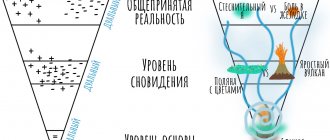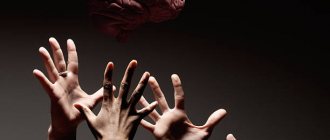Body-oriented psychotherapy is a way of getting rid of emotional experiences through interaction with the body. Everything we experience is reflected in our body. Negative and traumatic experiences are recorded in the body in the form of clamps and tensions.
A body therapist helps you pay attention to tense points in the body, and through them, identify the experiences that caused them. Having understood the reason, you can already work with it - learn to free yourself from the past and its constraining influence.
Thus, the goal of body therapy is to get rid of the influence of negative experiences experienced in the past on the present.
The founder of body therapy is Wilhelm Reich. He was a student of S. Freud, but concentrated his attention on studying the effects on the body. His work was continued by many scientists in different countries of the world. Today, body-oriented psychotherapy has many directions and continues to actively develop.
Advantages of the method:
- The main advantage of body-oriented psychotherapy is its high efficiency .
- This type of therapy allows you to interact with the unconscious. 90% of our subconscious manifests itself non-verbally, that is, not through speech, but through the body. Bodily clamps are a reflection of negative experiences, conflicts that have not received a way out and are “fixed” in the body.
- A bodily psychotherapist reads these signals, helps to reveal their causes, release negative emotions from the soul, and, as a result, free the body from clamps.
- Body psychotherapy can prevent the development of psychosomatic diseases , which are caused precisely by internal conflicts and negative experiences that have not received an outlet.
Sometimes tightness and lack of contact with one’s body reaches the point that a person loses the ability to grasp his true feelings. In this case, feelings are replaced by consciousness - it “tells” a person in which situation one should experience admiration, interest, sympathy, and in which - rejection. At the same time, a person’s true feelings may be completely different from those that consciousness imposes on him. Such a contradiction can cause serious internal conflict. Therefore, it is important to work with your body and respond to its silent signals.
Oksana Barkova, psychotherapist, Gestalt psychologist:
In my work, I always pay attention to the Body, since it is impossible to work through any emotional or psychological difficulty without removing the bodily block.
Any difficulty has an imprint on the body, creating a kind of physical and emotional “shell”, not allowing you to more fully experience and realize your emotions, distorting them.
The body remembers everything from the moment of birth: emotions, situations, memories, so through the body you can work with any human experience.
Working through muscle tension, which is the basis of psychological difficulty, allows you not only to solve the problem, but also to move on to correct bodily regulation and rely on the body’s resources. This is the main difference and advantage of body therapy over other psychotherapeutic methods.
Integrative approach
In the modern world, many psychotherapists do not adhere to any one school, using different techniques depending on the situation, if this helps to progress in working with the problem. This is called an integrative approach. As one practitioner noted: “Therapy for me is something like soup. Depending on how much of each ingredient you use, the flavor and aroma will change.”
This approach is quite reasonable. In the end, schools of psychotherapy speak in different words about the same phenomena and, most likely, sooner or later they will come to a single concept - as has already happened, for example, with psychiatry.
In what cases will body therapy help?
This type of psychotherapy can be recommended in a number of cases, such as:
- severe stress (loss, divorce, separation and other life situations);
- conflicts in couples and in the family;
- difficulties in your career: difficulties in relationships with colleagues and superiors, inability to defend and defend your opinion, lack of satisfaction from work;
- constant bad mood, apathy, restless sleep, tearfulness, depression;
- loss of meaning in life;
- fear, obsessive anxious thoughts;
- aggression, irritability;
- frequent colds, long-term illnesses.
It is important to note that body-oriented psychotherapy is not a replacement for conservative or surgical treatment of diseases, but serves as its complement.
Why is working with the body important?
A person experiences reality only through the body. When the connection between soul and body is broken, a person feels the world of his own experiences and illusions more realistically than the surrounding reality. As a result, the brightness and fullness of feelings and emotions is lost, nothing brings pleasure, and something is constantly missing in life. Some characterize this state as follows: “I live like a zombie,” “Like in a dream,” “Like frozen.”
In order to “return” to the real world again, to fully experience it, you must first free your body. Muscle “armor” makes it very difficult not only to enjoy life, but even to breathe and walk. Imagine that they put two sheepskin coats on you and put on heavy felt boots with galoshes. And you live 24 hours a day, even sleep, in such clothing. Now take and throw off this burden, remaining in light summer clothes. It's better, right? But no external conditions have changed, only your body has gotten rid of heaviness. Therefore, body-oriented therapy, working with muscle tension and returning the body to its original, harmonious state, helps solve psychological problems.
Comment from a SELF center specialist:
A man came for a consultation, his name was Ivan, 32 years old, with a request about his relationship with his wife - there had been an affair. During the meeting, the man, describing his situation, lowered his head down, breathed shallowly and periodically clenched his jaw. I drew his attention to how his body behaved when he described his difficulty. It turned out that for several months now his right shoulder has been hurting, constantly, nothing helps, the pain radiates to the shoulder blade and spreads along the spine.
We began to explore this pain and its connection with what the man was experiencing and thinking.
– What word is associated with pain?
- Sharp, sharp, furious.
At the same time, Ivan began to clench and unclench his fists, his breathing became more “heavy.”
“What emotion is asking to be noticed?” – I asked. The man, restraining himself, replied that it was anger, rage, a desire to break something and hit someone.
Then I asked: “What are these emotions trying to protect, what feeling or image?” The man answered with tears in his eyes that this was powerlessness, despair and the inability to return to his previous relationship with his wife.
After these words and allowing himself to be with the feelings of sadness, powerlessness, anger, despair, he was surprised to notice that the muscles relaxed and the pain went away. The emotional tension created by this feeling affected the muscles, causing them to spasm, blocking natural movement. And they immediately relaxed as soon as the emotion was identified and lived.
Seven segments of the muscular carapace
As noted earlier, the main clamps occur in seven main areas of the human body: eyes/head, mouth, neck/throat, chest, diaphragm, abdomen and pelvis. Armoring of these segments can easily lead to breathing problems, poor circulation, limited mobility and spasms. Let's look at each segment in more detail, and start with the most intimate area.
- Taz.
Muscle tension in the pelvic area appears when arousal and pleasure are suppressed. This is where grievances towards one’s own self, prohibitions on feelings, etc. accumulate.
Helpful advice: Clamps don’t just appear - they also have a purpose and task. They act as a kind of shield against fears, dissatisfaction with what is happening and injustice. Only by overcoming the stiffness in the muscle part and regaining the recklessness in terms of free expression of emotions can you experience your body again.
Clamps in the intimate area are massaged with hands while lying on your back. All muscles in the pelvic area and their clamps are responsible for sexual arousal and suppression of it as such. After the massage, you can swing your legs while lying on the floor and accompany the blows with screams.
- Stomach.
In addition to cramps due to diseases of the internal organs, the abdomen may have tension caused by fear of attack and suppressed anger and hostility.
- Diaphragm.
We are talking about the area involved in breathing. If a person is afraid or in a state of anger, the diaphragm contracts and is tense when the fear becomes constant. This creates problems with air entering the lungs and provokes fear and anxiety. In addition, such tension disrupts blood flow.
- Rib cage.
What is the basis of life if not breathing? Moreover, the expression of emotions is also based on it. If there is no tension and negativity in the body, it moves along with the breath, but if you need to control your emotions and tame them, you have to monitor your breath.
A signal indicating tension in this area is a change in breathing rhythm: the chest becomes tight and does not move. The subtext of this reaction of the body is a feeling of fear. A protruding chest means that it is undesirable to even approach a person. Some people never fully expand their chest, which signals depression and a lack of something.
You can correct the situation by learning to breathe correctly. To loosen the muscles, you need to work on striking and tearing objects with your hands. You can use a pillow. The main thing, at the same time, is to vividly imagine life situations in which anger, laughter or passion were restrained against your will.
- Neck/throat.
In this segment, a person keeps his protection from unpleasant information. As a rule, this clamp is caused by feelings that a person considers inappropriate.
Important: Considering that the segment is associated with the muscles that influence sound production, it can affect the voice, which can become hoarse and monotonous or, conversely, become too high without halftones and sound tense.
As a rule, clenching the jaws prevents the voice from opening, signaling a person’s desire to protect himself from the outside world in every possible way, and the fear of letting someone into his comfort zone. The suppressed desire to bite also causes clamping. In fact, such a desire means restraining angry impulses.
- Mouth.
The main human way of communication is the mouth. Tension in this segment appears when a person does not allow himself to express in words his feeling of what is happening, accumulating resentment and hatred. This type of clamp resembles a discreet smile, almost a smirk.
To relieve tension, you need to “contort” in front of the mirror, cry, roar, grimace, even imitating vomiting.
- Eyes.
It is believed that the eyes are the mirror of the soul. Reich believed that they also reflected a psychological state. The expression of the eyes can reflect the state of relationships in his family and beyond. People who know firsthand about chronic stress often suffer from tension in the eye area. If ignored, it can spread to the forehead, head and neck. Reich cited suppression of crying, an attempt to hide fear and anger, and a desire to hide as the reason.
To relieve tension, you need to get comfortable and relax. Then choose any point opposite you and focus on it, then widen your eyes as if this point scared you. Don't forget to breathe while doing this.
Finally, make circular eye movements and left-right eye movements several times.
Body-oriented therapy techniques:
There are different methods of body therapy:
- massage,
- breath,
- various exercises that can be done standing, sitting, lying down.
The purpose of the techniques is not to “fix” the body. They are aimed, first of all, at realizing the body and restoring connection with it.
Often a “side effect” of body-oriented therapy is an improved figure.
The fact is that drooping shoulders, incorrect posture, and sunken chests are often associated not with poor physical fitness, but with psychological problems. Unfulfilled desires, driven-in fears, complexes, worries, emotions that cannot find a way out accumulate in our body, causing it to bend and become ossified. When negative energy is released during therapy, the body straightens, becomes flexible and relaxed.
How do body therapy sessions work?
The first task of a body therapist is to determine what internal problems prevent you from fully enjoying life and freely controlling your body. To do this, he identifies a problem area - an area of the body where the muscles are constantly and unnaturally tense, and there is pain. This is an indicator that allows you to understand what is troubling a person - after all, this is the reason that caused the muscle tension. When it is possible to determine the cause, a physical psychologist offers special exercises that help to re-experience the condition that caused stress in order to let it go forever. A sign that the old problem has really been released will be the body - it will relax, getting rid of tensions.
Physical contact during communication between the therapist and the patient is not necessary - its presence or absence depends on the wishes of the patient. The work can also be done verbally, without touching.
It is worth noting that touch has a high psychotherapeutic effect, but only if the patient is disposed to this form of communication with the therapist.
Wilhelm Reich
Wilhelm Reich
The founder of body-oriented psychology, Wilhelm Reich, was born on March 24, 1897 in Galicia, which at that time was part of the Austro-Hungarian Empire.
Early in his career, Wilhelm Reich was an assistant to Dr. Sigmund Freud. However, later their paths diverged.
Wilhelm Reich became interested in science and bioenergy and created his own direction in psychology.
In 1939, Reich moved to New York where he first presented to the world his concept of ORGONE (Latin: ORGANISMUS - living being) - the omnipresent vital energy, the driving force of the Universe, which will fill all life on earth.
ORGONE, Reich argued, circulates freely throughout the human body, but only if there are no muscle tension in the body.
As soon as a person's body becomes constricted, the natural flow of energy is disrupted, which leads to illness.
In fact, the concept expressed by Reich was not something new.
The description of ORGONE is very similar to the description of vital force - QI Energy, on the basis of which Chinese medicine has been built for thousands of years.
Other eastern practices are also based on the understanding and control of life energy, which has different names in different cultures.
An innovation was Reich's invention - a technical device that allows one to concentrate ORGONE and direct it into the human body.
Wilhelm Reich's orgone accumulator (1939)
Using this device, which was called ORGONE BATTERY , Reich conducted experimental treatment of people suffering from incurable diseases such as cancer, angina, epilepsy and others.
There are several confirmed cases of cure for potentially hopeless patients.
However, these facts have been questioned by the scientific community. Reich was denied a license to manufacture the ORGONE ACCUMULATOR.
Moreover, Reich’s activities related to the study of ORGON and the use of hardware for the accumulation and control of ORGON were prohibited by the authorities.
Disobeying the authorities, Reich continued his research into ORGON, for which he was arrested.
Some time later, in 1957, Wilhelm Reich died in prison.
The official cause of death is a heart attack, but there is evidence indicating the violent death of the scientist...
How to choose a body therapist?
To choose “your” body therapist, pay attention to the following points:
- Techniques used by the specialist. Everyone has their own preferred techniques of body-oriented psychotherapy. Some people work with breathing, others use massage. Choose a therapist who knows the technique that will be comfortable for you.
- Where do therapy sessions take place? It is important that the room is cozy, that it has a comfortable temperature, good, but not too bright lighting. These are necessary conditions in order to relax and concentrate on your feelings.
- Subjective impressions. The specialist you will work with should evoke positive emotions in you. Don’t try to analyze your feelings - just feel whether you want to go to this therapist or not. A positive attitude is the basis for building the trust that is necessary for effective therapy.










